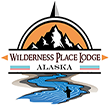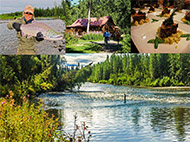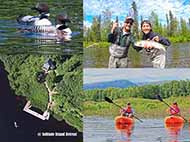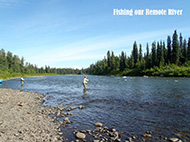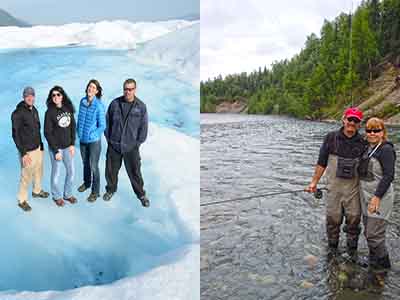Wilderness: Alaska's Last Frontier. Preserving it's Wild Places
Fishing Lodge Home › Alaska Articles › Wilderness: Alaska's Last Frontier
2021 New Year's Resolutions: Preserving Alaska's Last Great Wilderness Areas
copyright, Wilderness Place Lodge, December 22, 2020
"There are wild places and then there is everywhere else."
For those of us that are privileged to live in or regularly visit a region where wild places abound, we need to be sure not to take them for granted and do our part to protect them. For it is up to those that value nature to preserve it. When something’s value is not shared, it inevitably will cease to be. There are endless intrinsic qualities of natural things that are essential. Biodiversity within wilderness across the globe is essential to the health, livelihood and the future of our planet and our existence as a species. As wild places become more fragmented, we will continue to struggle to maintain a healthy balance. This will lead to great adversity that we will struggle to abate. History shows continual fragmenting of our environment leads to such anomalies such as climate change and pandemics, both of which are presently on the forefront of our minds and hearts.
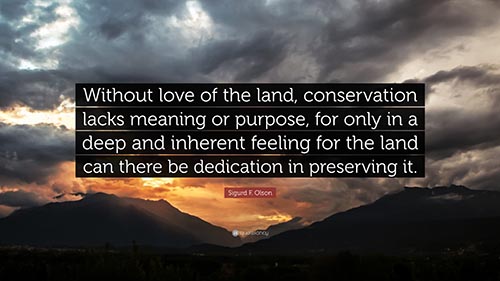 Alaska is lucky that it is still mostly wild. Alaskan’s are proud of their wild places and rightly so. Likewise, non-residents are eager to visit Wild Alaska as wilderness becomes more and more rare world-wide. Tourism is a dramatic spur to the state’s economic present and will likely have an increasing impact in the future, but only if Alaska maintains what visitors seek. Wilderness gives Alaska it’s charm, beauty and true value. All this is lost if wild places are replaced with human-creation. In Alaska, like in all remaining wild places, we should all consider what we currently have before it is lost forever. The state of Alaska is home to our nation’s last great unbroken wilderness, a wilderness that was once thought to be “inexhaustible.” Sadly, unless residents and non-residents choose to act, Alaska’s wilderness will be fragmented and succumb to a similar fate like countless other former paradises now lost. This may be the most pivotal time in Alaska’s history for her people to stand up and choose wilderness over progress. For we all know that government money could be used to improve what we already have access to rather than paving our natural paradise. There is plenty of access to public land and plenty of economic potential within the current developed regions of the state. There is no need to continue to exploit places that should be left to their original beauty.
Alaska is lucky that it is still mostly wild. Alaskan’s are proud of their wild places and rightly so. Likewise, non-residents are eager to visit Wild Alaska as wilderness becomes more and more rare world-wide. Tourism is a dramatic spur to the state’s economic present and will likely have an increasing impact in the future, but only if Alaska maintains what visitors seek. Wilderness gives Alaska it’s charm, beauty and true value. All this is lost if wild places are replaced with human-creation. In Alaska, like in all remaining wild places, we should all consider what we currently have before it is lost forever. The state of Alaska is home to our nation’s last great unbroken wilderness, a wilderness that was once thought to be “inexhaustible.” Sadly, unless residents and non-residents choose to act, Alaska’s wilderness will be fragmented and succumb to a similar fate like countless other former paradises now lost. This may be the most pivotal time in Alaska’s history for her people to stand up and choose wilderness over progress. For we all know that government money could be used to improve what we already have access to rather than paving our natural paradise. There is plenty of access to public land and plenty of economic potential within the current developed regions of the state. There is no need to continue to exploit places that should be left to their original beauty.
Wild places on earth are dwindling everywhere. We can all agree to this fact. You could say they are critically endangered. Without them, are we as well? Nature continues to be overwhelmed by human progress. Our increasing population accelerates demand for land, jobs and money as we continue to surpass the carrying capacity of the land to sustain itself and us. Progress happens fast without much concern for initial impact, lack of foresight and limited public involvement. This is where those that care need to draw the line as the fate of wild public lands should ultimately be decided by the public at large, but a 'voice in the wilderness.' It is in everyone’s best interest to have a say. The saga of man versus wild has had a devastating impact on our nation’s natural resources when development wins out. The next chapter of this saga is being aggressively pushed forward here and now, spearheading access into the heart of Alaska’s backcountry. This will result in considerable risks with irreparable ecological consequences. The touted benefits for the state’s people and economy should be debated as they are misleading. Landscape exploitation always begins with building access. Once access to an area is established, it will inevitably be shared with other interest groups who have their own near-sighted economic endeavors. The domino effect ensues. It’s believed by those with untrained consciousness that wilderness can be developed in such a manner that is symbiotic, in mutual harmony for both man and nature. This simply is not true. In the aftermath of progress, we do our best to establish management practices to achieve balance to the best of our ability, but what once was truly wild no longer is nor will be. For every action, there is an equal and opposite reaction. Alaskans need to decide their priorities before misguided progress derails Alaska’s greatest asset.
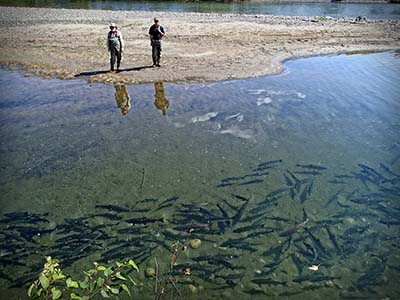 Many proposals are currently on the docket that would fragment Alaska’s wild places in exchange for financial gain. In the wake of a slowing economy, compounded by a year-long pandemic, Alaska, it’s economy and the bulk of it’s residents sit on pins and needles. Times are difficult for many. Times like these are the most opportune time for economic-driven, development-minded groups to push forward agendas that inevitably threaten wilderness: Alaska’s last frontier and most valuable asset. Roads, Mining, Bridges, Gas Lines, Dredges, Ditches, Gutters, Gravel Pits and Dams are current proposals on Alaska’s aggressive agenda towards paving paradise. Is this really a good use of of the state's finances during these times, or any time for that matter? One road always leads to more, one permit to another and one project spurs the next. It only benefits the minority. All along it is promised that “…the good citizens of our state will be those to ultimately benefit.” This is historical tendency we have. It is a jaded history of misguided proposals we choose regardless of what is sacrificed. Now would be a good time to break the chain and Alaska is the last best place to practice preservation over exploitation. For citizens of Alaska along with all those that hold wilderness dear, the first step is awareness and education. Be aware of what is happening. Be aware of proposals that are occurring. Public notice slips through the cracks when the powers that be hope to push their agenda forward with little to no resistance.
Many proposals are currently on the docket that would fragment Alaska’s wild places in exchange for financial gain. In the wake of a slowing economy, compounded by a year-long pandemic, Alaska, it’s economy and the bulk of it’s residents sit on pins and needles. Times are difficult for many. Times like these are the most opportune time for economic-driven, development-minded groups to push forward agendas that inevitably threaten wilderness: Alaska’s last frontier and most valuable asset. Roads, Mining, Bridges, Gas Lines, Dredges, Ditches, Gutters, Gravel Pits and Dams are current proposals on Alaska’s aggressive agenda towards paving paradise. Is this really a good use of of the state's finances during these times, or any time for that matter? One road always leads to more, one permit to another and one project spurs the next. It only benefits the minority. All along it is promised that “…the good citizens of our state will be those to ultimately benefit.” This is historical tendency we have. It is a jaded history of misguided proposals we choose regardless of what is sacrificed. Now would be a good time to break the chain and Alaska is the last best place to practice preservation over exploitation. For citizens of Alaska along with all those that hold wilderness dear, the first step is awareness and education. Be aware of what is happening. Be aware of proposals that are occurring. Public notice slips through the cracks when the powers that be hope to push their agenda forward with little to no resistance.
Be in the know! Here are some exceptional resources for current proposed projects in Alaska that threaten wilderness areas, salmon rivers, wetlands, riparian habitats, upland wildlife, water quality, marine ecosystems, biodiversity, and your 'big back yard.'
- The Susitna-Watana Dam Project Proposal – Would be the 2nd largest dam in the U.S. if established, damming one of Alaska’s largest and richest wild salmon river. Enough said. Must Read: https://www.susitnarivercoalition.org/the-susitna-watana-dam - https://wildsalmoncenter.org/campaigns/susitna/
- The West Susitna Mining Access Road – A mining road (for starters) for an Australian-based company to unearth minerals that crosses expansive wetlands, critical habitat and pristine salmon streams. Future mineral, gas, oil and infrastructure development are major concerns with unlimited adverse ecological impacts. Promises that it will be in the best interest of Alaskans is highly contested. The project economically is irresponsible and the long-term consequences are significant. Greater influx of sportsmen & recreators will strain fish and game populations and result in restrictive fishing and hunting, not greater opportunities. Must read: https://www.susitnarivercoalition.org/west-susitna-mining-rd
- Offshore Oil project expansion in Cook Inlet and it’s inevitable adverse impacts on the marine ecosystem, wild salmon, aesthetics and the fisheries industry: https://inletkeeper.org/2020/12/10/dunleavy-chooses-oil-over-salmon-in-cook-inlet/
- Old growth logging and deforestation of the Tongass National Forest (“The Salmon Forest”) in Southeast Alaska: http://www.americansalmonforest.org/ -- https://alaskaconservation.org/take-action/preserve-the-tongass/
Get involved! Organizations that offer fresh perspectives, access to insider knowledge, educational resources, volunteer opportunities, local events, national outreach and environmental research abound! Here are a few that have been involved in providing sound pubic resources regarding threats to Alaska’s wild places:
- The Wild Salmon Center: https://wildsalmoncenter.org/work/where-we-work/alaska/
- Susitna River Coalition: https://www.susitnarivercoalition.org/
- Trout Unlimited Alaska: https://www.tu.org/project/alaska/
- Cook Inletkeeper: https://inletkeeper.org/
- Alaska Conservation Foundation: https://alaskaconservation.org/
- Save Bristol Bay, Pebble Mine Updates, etc: http://www.savebristolbay.org/
Once we build access to wild places, they are no longer wild. Access leads to development which leads to inhabitance which leads to demand. Demand results in increasing infrastructure, which inevitably has environmental sacrifice. There is no trade-off if you feel that a true wilderness must be preserved. There is no way to keep wilderness wild while we ‘build Alaska out.’ Alaska can be an exception to history and stand up for wilderness preservation. If any state can do it, it’s Alaska.
"There are wild places and there is everything else." What do you value? What will you stand for?
“And so when we talk about intangible values remember that they cannot be separated from the others. The conservation of waters, forests, soils, and wildlife are all involved with the conservation of the human spirit. The goal we all strive toward is happiness, contentment, the dignity of the individual, and the good life. This goal will elude us forever if we forget the importance of the intangibles.”
-- Sigurd F. Olson
